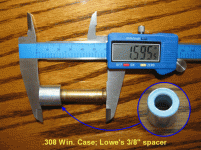Jwilson904,
Where you are measuring the case head diameter is very close to what is normally called the pressure ring (where your splits are occurring). I can't tell from the end-wise photo of the measurement exactly where you are picking it up. 0.003" of expansion is within SAAMI standard chamber dimensions for 30-06 at that point where the split is occurring and a fraction behind it. (Chambers are always wider than cartridges so they will feed properly.) To measure head expansion, try picking it up just barely in front of the extractor groove relief angle or across the bottom flats in the extractor groove, but definitely well clear of where your cracks are appearing.
I still get back to commercial ammunition not causing the split. Even though your rounded primer suggests excess pressure is impossible, sometimes odd things happen, so, just-in-case, let's check a few other basics:
Make sure your sizing die has "30-06" stamped on the side of it and not something else.
Weigh your bullets to be sure heavier ones weren't put in the box by mistake. I've seen wrong bullets come in a box before.
Checked the diameter of the bullets to be sure they are actually .308 and not 8 mm (0.324").
Checked that the trim length of your cases does not exceed 2.494"?
Measure your handload's case neck OD just below the mouth. It should not exceed .334" with the bullet seated.
Let's get a stretch number just to confirm your gunsmith's finding. If you don't have a case comparator, use the method illustrated below for a .308 to compare an unfired new case to a fired one to see how much growth you've got at the shoulder. Note that the Lowe's spacer shown tends to be oversized, which is fine for .308 with it's wider shoulder that has a 0.400" datum diameter. You should take a case to the store with you and find a spacer that lands roughly in the middle of the shoulder. 0.375" is ideal, but this is a comparison, not an absolute measurement, so anything approximate is good enough. Let's also get a reading on a case you fired from commercial ammo and then resized.

The bottom line here is that the case is stretching the brass too thinly at the pressure ring, so it stretches until it cannot contain pressure and it cracks. Unless the case gets scored over the pressure ring, there is no other mechanism for causing the crack that I am aware of. Excess pressure will stretch the whole chamber so that even though the headspace is good (bolt closes on a GO gauge but not on a NO-GO gauge) the case still stretches too much. If the case is too short for the chamber (excess headspace) that will cause the stretching. We just need to figure out what mechanism is causing it.
If you know someone else who reloads and has some different powders and bullets, let's put together a very standard load of the type used in match shooting with the Garand. A 150-grain FMJ bullet or match bullet over 49 grains of IMR4895. A 168-grain match bullet over 47.5 grains of IMR4895 or 48 grains of IMR4064. QuickLOAD's database thinks you would need about 1.4 grains more Accurate 4064 to match pressure with IMR4064, but your components are suspect until we figure it out. You might also load the rounds on his equipment, if possible, to eliminate your dies and the like.

